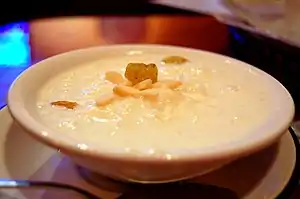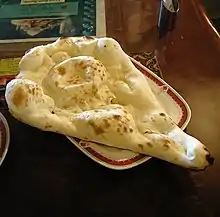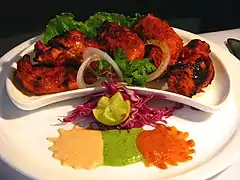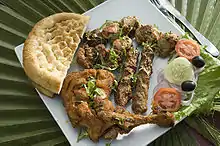 A bowl of kheer | |
| Alternative names | Payasam, Payesh, Ksheeram, Doodhpak |
|---|---|
| Type | Pudding |
| Course | Dessert |
| Place of origin | South Asia |
| Main ingredients | Rice, milk, sugar, cardamom, jaggery, saffron, pistachios or almonds |
| Variations | Barley kheer, Kaddu ki kheer, paal (milk), payasam, payesh, chhanar payesh (payesh made with chhana or paneer) |
| 249 kcal (1043 kJ) | |
Kheer, also known as payasam or payesh, is a pudding/porridge popular in the Indian subcontinent, usually made by boiling milk, sugar or jaggery, and rice. It can be additionally flavored with dried fruits, nuts, cardamom and saffron. Instead of rice, it may contain cracked wheat, vermicelli (sevai) or tapioca (sabudana).[1]
Etymology
The word kheer is derived from the Sanskrit word for milk, kshira (क्षीर). Kheer is also the archaic name for sweet rice pudding. The word pāyasam used in South Indian circles is related to the Sanskrit payas, 'rice'.
Origin
Kheer was a part of the ancient Indian diet.[2]It is believed that the dessert originated 2000 years ago in the Jagannath Temple in Orissa.[1]
According to the food historian K. T. Achaya, kheer or payas, as it is known in southern India, was a popular dish in ancient India. First mentioned in ancient Indian literature, it was a mixture of rice, milk and sugar, a formula that has endured for over two thousand years. Payas was also a staple Hindu temple food, in particular, and it is served as Prasāda to devotees in temples.[3]
Gallery
 Kheer topped with dried fruits and nuts
Kheer topped with dried fruits and nuts Kheer
Kheer Paal payasam
Paal payasam Kheer with vermicelli (called seviyan kheer, semiya payasam or shemai)
Kheer with vermicelli (called seviyan kheer, semiya payasam or shemai) Vermicelli kheer
Vermicelli kheer
See also
- Porridge
- Phirni - a dessert made with ground rice or rice flour cooked in milk and eaten chilled
- Shir Berenj - Persian rice pudding
- Doodhpak - Gujarati rice pudding
- Shemai - Bengali vermicelli pudding
- Sheer khurma - Persian vermicelli pudding
References
- 1 2 "Best Rated Puddings in the World". www.tasteatlas.com.
- ↑ "Kheer: The Quintessential Indian Milk Affair". 27 July 2016. Archived from the original on 10 February 2017.
- ↑ "A truly international dessert". Hindustan Times. 3 October 2009.



